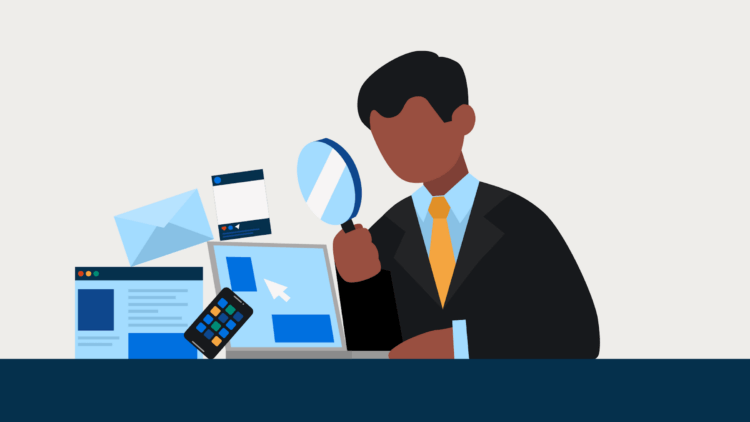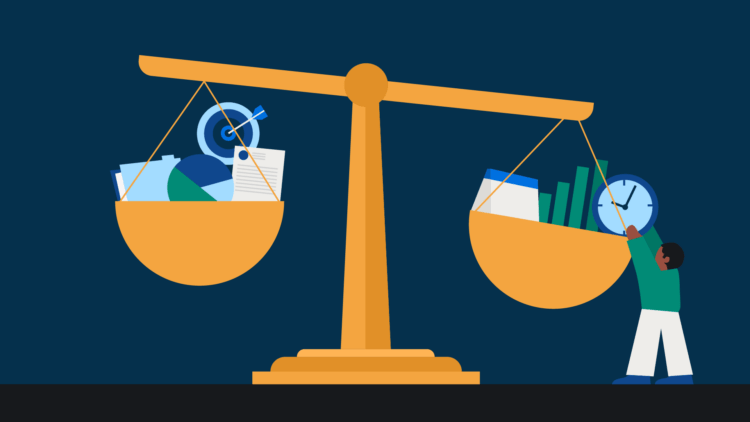When you think of data, you might think of charts, graphs, or numbers racing across a screen at a mile a minute. With that view, becoming a data-driven lawyer might seem complicated—but it’s actually easier than you might think.
Becoming a data-driven lawyer is less about advanced data analysis and more about keeping track of straightforward indicators of success—such as how you spend your time and how many hours you bill for each month.
We spoke with Joshua Lenon, Clio’s Lawyer in Residence, and George Psiharis, Clio’s VP of Business Development, for more insight and advice on becoming data-driven and creating a more efficient and profitable law firm.
1. Use a system of record
As a first step towards becoming more data-driven, George suggests using a system of record to keep track of everything going on in one’s practice. “It seems obvious, but I think using a system of record in the first place can make a big difference,” he said. “It’s a simple transition most people can make, especially if they use what’s right for them.”
While George strongly recommends using a cloud-based practice management system to keep track of things like time and revenue, he added that there are other options available. “Even if you can use some kind of tallying system to keep track of your clients and your billable hours, or of things like how you attracted potential clients that turned out to be good clients for you, you can start to make data-driven decisions in really simple ways,” he explained.
For example, the 2019 Legal Trends Report found that lawyers only bill an average of 2.5 hours per day. Simply knowing where your time is going can help you know if you need to shift your focus or make changes. To get an objective view of where you spend your time, George suggests opening a matter to track time spent on administrative tasks:
In the 2017 Legal Trends Report, we talk about the different categories that people are spending time on. Business development is a big one at 33%. Combined administrative tasks is huge category at 48%. Collections is another one that takes up time, and another one is CLE.
CLE we can’t directly do much about. But with the other categories, technology can help streamline those things. Also, just being deliberate in paying attention to these areas and deciding to minimize the amount of time you spend on them is a really important first step.
Clio Manage’s Firm Dashboard takes the manual work and time out of tracking your firm’s key productivity and revenue metrics—showing you how many billable hours your firm has captured, billed, and collected in one central, visual dashboard. With these insights collected for you, it’s easier to track performance, set goals, and make data-driven business decisions for your firm.
2. Set goals
Using a system of record to collect accurate data on your practice and how you’re spending your time is a great first step. But before you can start using any of that data, you need to have goals—and those goals need to be specific to you and your firm. Consider this example from Joshua:
A lot of lawyers don’t need to bill eight hours a day to meet their financial goals, but they do need to bill a certain number of hours per day. Knowing that goal in advance allows them to schedule their days and free up their time for things like business development, networking, or refreshing their skills.
Note: You can easily set Practice Performance targets in Clio to help track progress towards your goals.
Indeed, if you set goals and track your progress towards them, you’ll be ahead of much of your competition: A survey conducted in partnership with Above the Law as part of the 2017 Legal Trends Report found that many legal professionals are working without daily or annual targets, making it difficult to quantify success—or to identify areas for improvement. From the report:
-
Only 54% of legal professionals can estimate their annual billings for 2017, which suggests many law firms can’t predict how much they will make in a year.
-
Only 40% of firms that track time have hourly billing targets, which suggests the majority of firms don’t have goals for how much they should work in a given year.
-
Only 50% of legal professionals can bill a case based on a set budget, which suggests a lack of transparency and expectations for both the lawyer and their client.
In addition to tracking targets for billable hours, George suggests tracking response rates for inquiries about representation (67% of consumers surveyed for the 2017 Legal Trends Report said that responsiveness was a key factor in choosing a lawyer). If you charge flat fees for your services, it’s also worth looking at how much time you’re spending on specific cases and services to ensure your model is profitable—or to look for ways to improve efficiencies and margins.
“What do you care about? What numbers or statistics can represent making progress towards a goal related to what you care about? And what can you be tracking through a system of record to do simple reporting?” George said.
You may like these posts
3. Be proactive, not reactive
When is the right time to start using data in your law firm? George suggests starting sooner rather than later, and stresses it’s best not to wait until you’re facing troubles:
[Being more data-driven] is a proactive change I think people need to make versus a reactive one,” he said. “If you’re in firefighting mode, it can be a barrier to saying, ‘okay, I’m going to sit down, I’m going to run my business with a plan, I’m going to look at how I’m doing versus targets for certain key performance indicators.’ I think it’s more of that mindset shift.
For example, consider the subject of free consultations. Are they useful, or not? Likely, it’s better to answer that question for your practice before you start worrying over time spent on consultations.
“Over a month of free consultations, what are the conversion metrics?” Joshua asks. “What was the lost opportunity in terms of billable hours compared to that? If I give 30 hours of free consultations a month and only two of those consultations result in a new client, do they make up for, or give me a profit beyond, what could have been 30 billable hours with my existing clients?”
The importance of being proactive can also be seen when looking at seasonal trends in the legal market. As Joshua explains:
We know from data in the Legal Trends Report that legal work tends to be seasonal, so a good month now may presage a lean month to come. Knowing that will allow you to say ‘you know what, I’m going to have a lean month coming up, so I’m going to take these eight to nine billable hours a day for now and put my business development and networking on hold temporarily because I need to build up these hours. And then, because I know there’s this lean period coming up, that’s where I can shift my workload towards business development and networking.
Using a system of record can help you gather the data you need to answer questions about whether free consultations are a viable business strategy for your firm, or about which months are busiest and leanest, so it’s best to start using one as soon as you can.
Remember that data doesn’t make decisions, it informs them
Data can be incredibly useful for your practice, but it’s important to set expectations about just how much it will do for you. In the end, data can give you information—or maybe a new perspective—to help you make better business decisions, but it can’t make those decisions for you.
If you bill 2.3 hours per day on average, and you take steps to streamline the rest of your workday, what would you do with the missing hours you recover?
“You could try to put them toward more work to make more revenue, and hit your personal revenue and billing targets. You could put them toward helping more people if you’re trying to improve access to justice. Or you could put them towards having a better work-life balance,” George said. “It all depends on what’s most important to you.”
With a system of record, a set of goals, and metrics to track your progress towards those goals, you’ll be well on your way to running a data-driven law firm. With a clear understanding of the importance and power of data, and a view of what’s motivating you to be data-driven in the first place, you’ll be that much further ahead.
We published this blog post in February 2018. Last updated: .
Categorized in: Business









